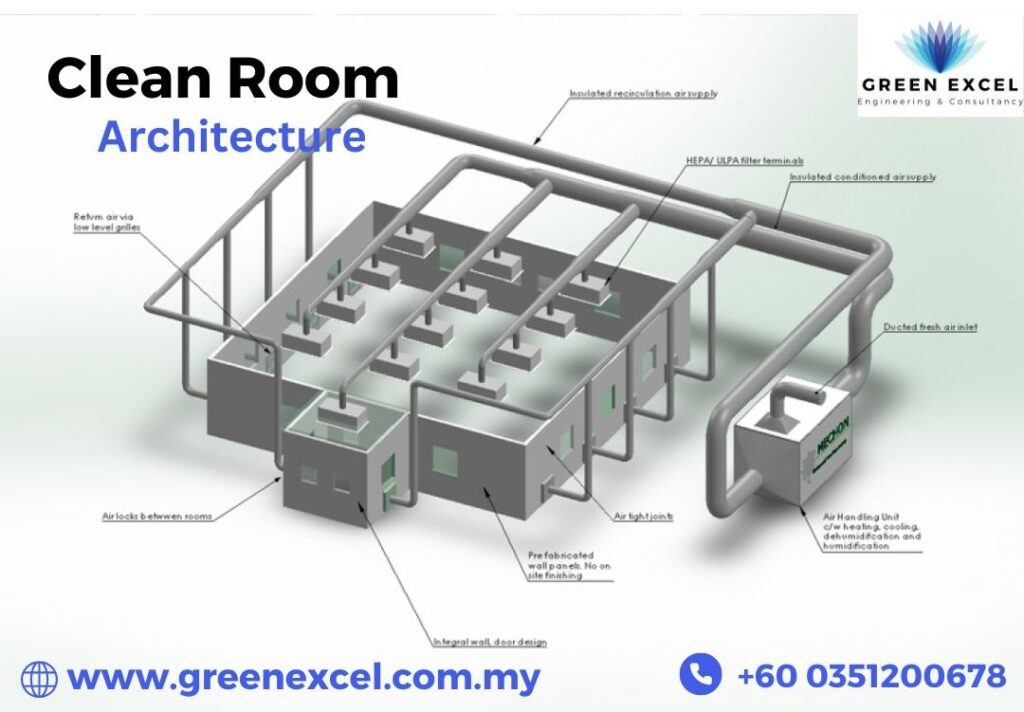Cleanrooms are special places where we keep everything super clean for important work. These rooms protect things from dust and germs. Big industries, like those that make medicines and computers, need cleanrooms. The rooms help them make sure nothing dirty gets inside. Cleanroom architecture is how we build these rooms to meet the strict rules for keeping them clean. More and more, industries ask for cleanroom standards to stay high, pushing builders to create better and smarter designs.
What Are Cleanrooms?
Cleanrooms are spaces where we block dirt and bad stuff from getting in. Workers use these rooms for making things like medicine or computer chips. In these rooms, the air stays very clean, and no dirt can float around. Everything stays pure and fresh.
These rooms follow strict rules set by experts. These rules tell us how clean the air needs to be. Cleanroom standards say how many dust particles can float in the air. Therefore, cleanroom architecture makes sure the rooms meet those tough standards.
Why Do Cleanroom Standards Matter?
Cleanroom standards help industries keep things clean. Without them, workers might make mistakes because of dust or germs. These standards save companies from losing money or making bad products. A good cleanroom design protects both people and products.
For example, in a factory making medicine, germs could sneak in and make the medicine unsafe. Cleanrooms stop that from happening. Additionally, this protects people who will use the medicine, and it keeps the factory out of trouble.
Cleanroom Architecture: The Heart of the Matter
Cleanroom architecture is what keeps the room clean all the time. The materials, air systems, and layout all work together to block out dirt. Cleanroom builders use smooth materials that don’t trap dust.
The air in the cleanroom moves in just the right way. Filters, like strong nets, grab dust and keep it out. Fans keep the air moving, so nothing stays still long enough to get dirty. Cleanroom architecture also controls temperature and how wet the air is. Too much heat or moisture can ruin the clean space.
What Makes a Cleanroom Work?
Cleanroom architecture depends on some key things to work well:
- Smooth Surfaces: Cleanrooms use special walls, floors, and ceilings that stop dust from sticking. These surfaces are easy to wipe clean.
- Air Control: Cleanrooms have fans that push air around in a way that keeps dirt out. The air moves from the cleanest places to the less clean ones, making sure it stays safe.
- Temperature and Moisture: Keeping the air cool and dry is important. Cleanrooms use systems that make sure the air never gets too hot or too wet.
- Special Lights: The lights in cleanrooms don’t create much heat, so they don’t disturb the clean air. These lights help people see without making the room dirty.
- Protecting the Doorways: When people enter, cleanrooms have special doors that block dirt. People must also clean themselves before going inside.
Why Do Industries Rely on Cleanroom Standards?
Industries need cleanrooms because they stop dirt from messing up their work. Cleanroom standards help them make safe products and follow the rules. These standards also help businesses avoid costly mistakes.
For example, in the medicine world, one tiny bit of dust could ruin a whole batch of pills. If that happens, the company loses a lot of money. Cleanrooms stop that by creating safe, clean places to work. This makes cleanroom standards super important.
Cleanroom Architecture and Growing Industries
Industries grow fast, and cleanrooms need to keep up. As new technology comes along, cleanrooms need to change and get better. Cleanroom architecture grows with these industries, finding new ways to stay clean and work smarter.
For example, some companies use modular cleanrooms. These are rooms that can change size or move when needed. Furthermore, cleanroom architecture is also becoming more energy-friendly. This helps save power while keeping rooms super clean.
Following Cleanroom Standards
Industries need to follow the rules to keep their cleanrooms safe. Cleanroom architecture helps businesses meet these rules by building smart designs. Regular checks make sure everything stays clean.
Companies work with special architects who know how to build cleanrooms. These experts make sure the cleanrooms not only follow the rules but also help workers do their jobs better.
Things to Think About in Cleanroom Design
Designing a cleanroom takes a lot of planning. Industries need to know how big the room should be, what kind of work will happen there, and how clean it needs to be. In addition, a cleanroom must be the right size for the work, and it should be easy to keep clean.
Cleanroom architects choose the best materials and systems for the job. These choices help keep the room clean and make it easy to upgrade if needed. Furthermore, good planning helps cleanrooms stay strong and last a long time.
Different Kinds of Cleanroom Standards
Different industries have different levels of cleanroom standards. Some rooms must be super clean, while others allow a bit more dust in the air. In addition, the International organization for Standardization (ISO) created a system to show how clean each room must be.
For example, a company that makes tiny computer chips needs a cleanroom with almost no dust, an ISO 1 cleanroom. But a food factory might use an ISO 8 cleanroom, where a little bit of dust is okay. Cleanroom architecture makes sure the room is just as clean as it needs to be, no more, no less.
The Future of Cleanroom Architecture
As industries keep growing, cleanrooms will need to keep changing. New ideas, like smart cleanrooms, are becoming popular. These rooms use computers to check for dirt and fix problems right away. Smart cleanrooms can also change things like air temperature and flow to stay clean.
Many industries are also thinking about how to build cleanrooms that use less power. Cleanroom architecture is finding ways to save energy while keeping rooms safe and clean. Additionally, the future is full of possibilities for smarter, greener cleanrooms.
The End Note
However, cleanrooms are key for modern industries. Cleanroom architecture and cleanroom standards make sure that these spaces are safe, clean, and effective. Without them, industries would face problems like contamination and unsafe products. Ultimately, cleanroom designs continue to grow and improve as industries evolve. By creating smart, energy-saving designs, cleanroom architecture helps businesses stay strong in a tough and changing world.






